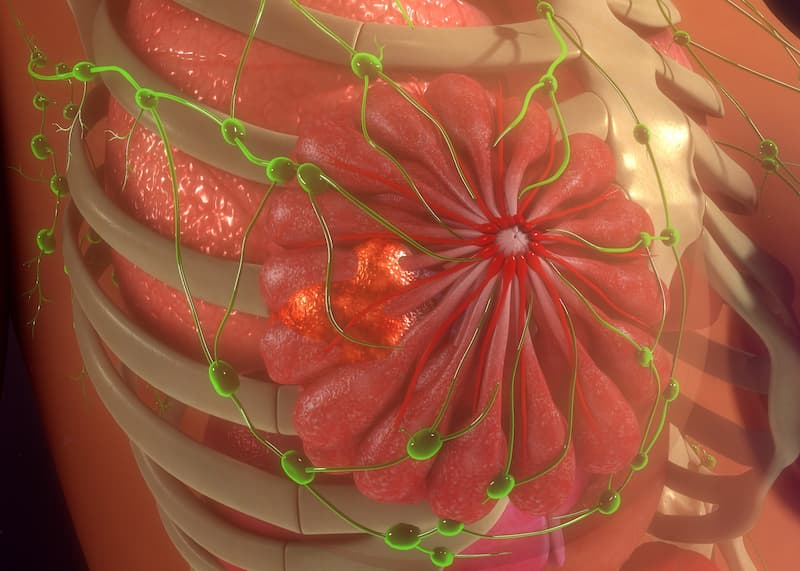Niraparib/Dostarlimab Shows Promise in BRCA+ ER+/HER2– Breast Cancer
Of 18 patients with BRCA-mutated ER+/HER2– breast cancer, 3 had a pathological complete response when treated with niraparib plus dostarlimab.
“Given the activity of preoperative PD-1 inhibition for ER-positive breast cancer, additional evaluation of targeted non-chemotherapy approaches is of great interest in this patient population,” according to study author Erica L. Mayer, MD, MPH.

Neoadjuvant niraparib (Zejula) plus dostarlimab-gxly (Jemperli) produced responses for a small cohort of patients with germline BRCA-mutated estrogen receptor (ER)–positive/HER2-negative breast cancer, according to data from arm C of the phase 2 TBCRC-056 trial (NCT04584255) presented at the 2024 San Antonio Breast Cancer Symposium.
Data showed that the pathological complete response rate (pCR) was 16.7% (90% CI, 4.7%-37.7%). Additionally, the residual cancer burden (RCB)-0/I rate was 44.4%, RCB-I was 27.8%, RCB-II was 22.2%, RCB-III was 22.2%, and those given additional neoadjuvant therapy had a response rate of 11.1%.
“Given the activity of preoperative PD-1 inhibition for ER-positive breast cancer, additional evaluation of targeted non-chemotherapy approaches is of great interest in this patient population,” Erica L. Mayer, MD, MPH, director of Clinical Research and Institute Physician at Dana-Farber Cancer Institute, and associate professor of medicine at Harvard Medical School, said during the presentation.
Investigators of arm C evaluated 18 patients with ER–positive/HER2-negative disease who were given niraparib plus dostarlimab for 18 weeks. Niraparib was given at 200 mg by mouth daily, and dostarlimab was given at 500 mg intravenously every 3 weeks. Patients were enrolled between April 2021 and May 2024.
To be eligible for treatment, patients needed to have germline BRCA1/2 mutations or germline PALB2 mutations, HER2-negative disease, stage I to III disease, and a tumor of 1 cm or more. Between arms A, B, and C, 64 patients were enrolled.
The median patient age was 41.8 years old, and 77.8% were White. At diagnosis, most patients had stage II disease (44.4%) followed by stage I (38.9%) and stage IIIA (16.7%). Of note, the majority of patients had a tumor grade of II (61.1%). A germline BRCA1 mutation was observed in 27.8% of patients vs 72.2% with BRCA2.
Regarding treatment exposure, 18 have completed therapy and received surgery. Prior to surgery, 2 patients were given additional neoadjuvant therapy, 83.3% completed 6 cycles of niraparib, and 61.1% completed 6 cycles of dostarlimab.
Regarding toxicity, the most common grade 3 treatment-related adverse effects included rash (27.8%), alanine transaminase increase (16.7%), and nausea (5.6%).
A total of 12 patients had evaluable paired basal-like (BL) and C2 stromal tumor-infiltrating lymphocytes (sTILs). There was an 11.9% increase in sTILs with exposure to therapy at 3 weeks. The mean increase was 11.9% to 23.8% (P = .09).
There were 17 patients with evaluable BL sTILs. For patients with higher sTILs, there was an association with pCR (P = .04) and a continuous overall response of 1.10 (90% CI, 1.01-1.20). For patients with sTILs that were higher at BL, there was an association with RCB0-I response (P = .09) and continuous OR of 1.08 (90% CI, 1.00-1.17).
“Increased baseline sTILs was associated with pathologic response at surgery,” Mayer said.
Regarding the background for this research, the pCR rates observed in those with triple-negative breast cancer (TNBC) have approximately been 50% for those receiving neoadjuvant PARP inhibitor therapy. Mayer noted that further research regarding TNBC was underway.
Although previous data suggested that adding an anti-PD-L1 therapy to a PARP inhibitor did not increase activity in patients with BRCA-mutated breast cancer, there may be room for this combination in less immunosuppressed early-stage settings.
“Additional exploration of the immunosuppressive components of the tumor microenvironment may help fully realize the impact of combining immunologic approaches with PARP inhibition,” Mayer concluded.
Reference
Mayer EL, Graham N, Leon-Ferre RA, et al. TBCRC 056: a phase II study of neoadjuvant niraparib with dostarlimab for patients with BRCA- or PALB2-mutated breast cancer: results from the ER+/HER2- cohort. Presented at the 2024 San Antonio Breast Cancer Symposium; San Antonio, TX, December 10-13, 2024. RF3-01
Newsletter
Stay up to date on recent advances in the multidisciplinary approach to cancer.